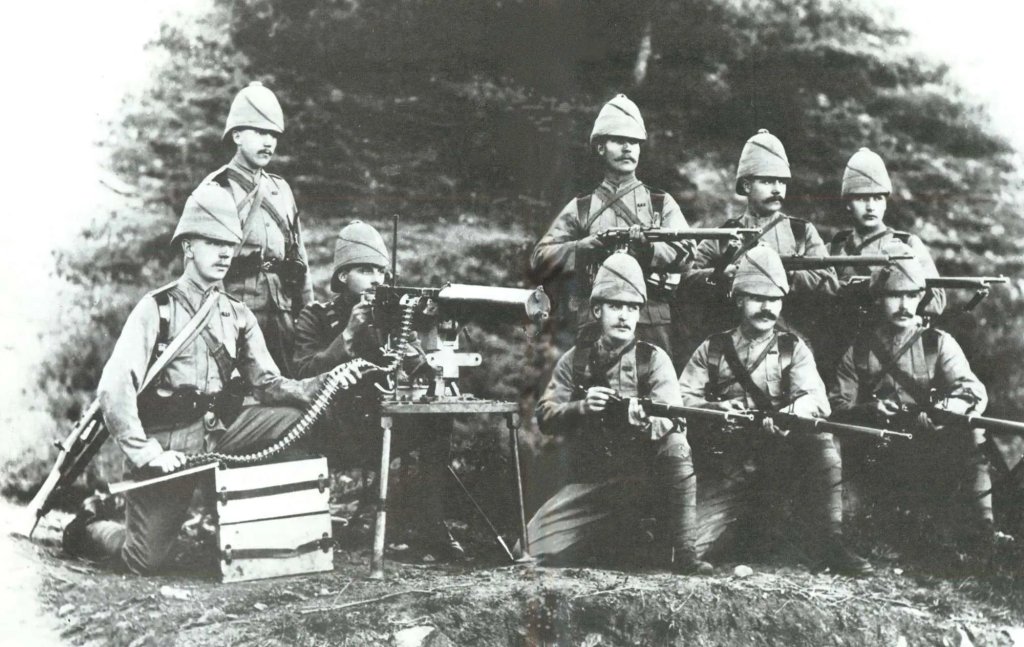

During the pre-dawn hours of October 25, 1893, a British column of 700 men from the British South African Police under the command of Maj. Patrick William Forbes camped in a defensive position next to the Shangani River. While they slept, the Matabele king Lobengula ordered an attack on the column, sending a force comprised of up to 6,000 men – some armed with spears, but many with Martini-Henry rifles.
Among its weapons, the column possessed five Maxim guns – history’s first recoil-operated, belt-fed machine gun. Once a British bugler sounded the alert, the machine guns saw action, and the results were horrific. More than 1,600 of the attacking Matabele tribesman were mowed down like grass. As for the British column, it suffered only four casualties.
The British military not only measured the Maxim gun’s success by the number of Matabele killed in action. They could gauge the Maxim’s potential as a weapon of psychological warfare. In the aftermath, several Matabele war leaders committed suicide either by hanging themselves or throwing themselves on their spears.
The Maxim gun was an earth-shattering a weapon in its heyday – and a true weapon of empire.

Hiram Maxim‘s invention brought industrial-level killing to the battlefield. More than any other weapon developed in the late 19th and early 20th Century, the Maxim gun is responsible for changing the nature of warfare forever.
The British square and “the thin red line” of massed infantry firepower eventually went the way of the dodo. When the Maxim gun opened fire at 500 rounds per minute, the tactic of soldiers firing in ranks became suicidal – from then on, the infantryman would have to dash and weave, relying on his ability to maneuver to bring fire to bear on the enemy and to stay alive.
The Maxim gun has two phases to its history. The first is when it was used as the weapon of choice to help expand the British Empire during the late 19th Century. The weapon’s devastating use during The Great War launched the second phase of its history as one of the guns of modern 20th Century warfare.
But to really understand the weapon you have know something about Maxim, an American who was both an impressive genius and a shrewd businessman.
Born in Maine in 1840, tinkering came naturally to Maxim. While still a teenager, he literally built the better mousetrap – his automatically reset and rid local mills of rodents. At 26, he patented a curling iron, the first of 270 more patents to come. Then, Maxim became chief engineer of the United States Electric Lighting Co. in New York, where he introduced longer-lasting carbon filaments for electric light bulbs.
But he wanted fame and fortune – particularly fortune. He went to Europe in an effort to seek wealth by developing peacetime inventions like he had in the United States.
“In 1882 I was in Vienna, where I met an American whom I had known in the States,” Maxim wrote in his memoir. “He said: ‘Hang your chemistry and electricity! If you want to make a pile of money, invent something that will enable these Europeans to cut each others’ throats with greater facility.'”
Sound advice: In 1884, he harnessed the recoil of a bullet with a spring-loaded bolt mechanism and feeding device that fed ammunition into the gun on a cloth belt. The Gatling or Nordenfelt rapid-firing guns of the time were hand-cranked, gravity-fed weapons with multiple barrels prone to jamming.
Maxim also invented a cleaner burning, smokeless powder that he called cordite, which fouled a weapon much less than the black powder of the era. The combination of mechanized automatic fire and cleaner ammunition was revolutionary. By 1889, the British army adopted the Maxim gun; a year later, the armies of Austria, Germany, Italy and Russia all had Maxims.
The quintessential incarnation of the Maxim gun came when the inventor partnered with the British Vickers Co. The result was a water-cooled, tripod-mounted machine gun in .303 caliber, fed by ammunition on a 250-round belt.

It came just in time for World War I. However, many generals and military planners doubted the effectiveness of the Maxim gun as well as similar machine guns against troops of Western European powers.
They still preached the bayonet charge. As one infantry manual said, “The spirit of the bayonet must be inculcated into all ranks, so that they go forward with aggressive determination and confidence of superiority born of continued practice, without which a bayonet charge will not be effective.”
Not even the evidence of the Russo-Japanese War (1904-1906) with its long sieges and trench warfare – an eerie predictor of The Great War’s horrors to come – could persuade military observers of the Maxim gun’s lethality on the modern battlefield.
“The observers watched Russian and Japanese being mowed down in swathes by machine-gun fire and returned home to write: The machine gun is a vastly overrated weapon; it appears highly doubtful that it would be effective against trained European soldiery,” James L. Stokesbury drily comments in A Short History of World War I. “Apparently, they did not consider Japanese, or even Russians, to be in that supposedly elite category.”

The reality on the Western Front was something quite different. Some called The Great War “the machine gun war” – although artillery fire often caused the bulk of the casualties, soldiers vividly recounted watching their comrades drop like flies as machine guns traversed their ranks while firing.
In just one day during the Battle of the Somme – July 1, 1916 – the British saw 21,000 men slaughtered. The great majority of the casualties were killed by Spandau machine guns, the German version of the Maxim.
Maxim – wealthy, famous, and knighted by the queen – died on November 24, 1916, in London, his home after he became a naturalized British subject. A few weeks before, the Battle of the Somme had ended. The result was more than a million casualties.
